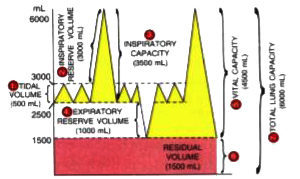What is the value of expiratory reserve volume (ERV) ?
Step-by-Step Solution:
1. Definition of Expiratory Reserve Volume (ERV):
- Expiratory Reserve Volume (ERV) is defined as the volume of air that can be forcibly exhaled after a normal expiration.
2. Understanding Normal Expiration:
- The normal expiration is referred to as tidal volume, which is the amount of air inhaled or exhaled during normal breathing.
3. Value of ERV:
- For a normal human adult, the value of the Expiratory Reserve Volume (ERV) ranges from 700 to 1200 milliliters (ml).
4. Conclusion:
- Therefore, the value of ERV for a normal adult is between 700 ml and 1200 ml.
---
- Expiratory Reserve Volume (ERV) is defined as the volume of air that can be forcibly exhaled after a normal expiration.
- The normal expiration is referred to as tidal volume, which is the amount of air inhaled or exhaled during normal breathing.
- For a normal human adult, the value of the Expiratory Reserve Volume (ERV) ranges from 700 to 1200 milliliters (ml).
- Therefore, the value of ERV for a normal adult is between 700 ml and 1200 ml.
Topper's Solved these Questions
- BREATHING AND EXCHANGE OF GASES Book:AAKASH INSTITUTE ENGLISHChapter:BREATHING AND EXCHANGE OF GASES Exercise:Try Yourself
Explore 40 Videos
- BREATHING AND EXCHANGE OF GASES Book:AAKASH INSTITUTE ENGLISHChapter:BREATHING AND EXCHANGE OF GASES Exercise:EXERCISE
Explore 30 Videos
- BODY FLUIDS AND CIRCULATIONBook:AAKASH INSTITUTE ENGLISHChapter:BODY FLUIDS AND CIRCULATIONExercise:Assignment Section - D Assertion - Reason Type Questions
Explore 9 Videos
- CELL CYCLE AND CELL DIVISION Book:AAKASH INSTITUTE ENGLISHChapter:CELL CYCLE AND CELL DIVISION Exercise:SECTION-D (Assertion-Reason Type Questions )
Explore 10 Videos
Similar Questions
Knowledge Check
The inspiratory reserve volume + tidal volume + expiratory reserve volume is the same as
Ainspiratory capacity + expiratory reserve volumeBtotal lung capacity − funcational residual capacityCinspiratory capacity + functional residual capacityDinspiratory capacity + residual volume.From the following relationship between respiration volumes and capacities, mark the correct option.
(i) Inspiratory Capacity (IC) = Tidal Volume + Residual Volume
(ii) Vital Capacity (VC) = Tidal Volume (TV) + Inspiratory Reserve Volume (IRV) + Expiratory Reserve Volume (ERV)
(iii) Residual Volume (RV) = Vital Capacity (VC) - Inspiratory Reserve Volume (IRV)
(iv) Tidal Volume (TV) = Inspiratory Capacity (IC) - Inspiratory Reserve Volume (IRV)A(i) Incorrect, (ii) Incorrect, (iii) Incorrect, (iv) CorrectB(i) Incorrect, (ii) Correct, (iii) Incorrect, (iv) CorrectC(i) Correct, (ii) Correct, (iii) Incorrect, (iv) CorrectD(i) Correct, (ii) Incorrect, (iii) Correct, (iv) Incorrect
Differentiate between the following pairs on the basis of what is given in the brackets :
Inspiratory reserve volume and Expiratory reserve volume (Volume of air)
View SolutionThe volume of air in the lungs and the rate at which it is exchanged during inspiration and expiration was measured.
The following diagram shows a group of the lung volumes and capacities :

Study the diagram carefully and explain briefly the following:
(a) Tidal volume
(b) Inspiratory reserve volume
(c) Expiratory reserve volume
(d) Vital capacity
(e) Residual volume
View SolutionFrom the following relationship between respiration volumes and capacities, mark the correct option.
(i) Inspiratory Capacity (IC) = Tidal Volume + Residual Volume
(ii) Vital Capacity (VC) = Tidal Volume (TV) + Inspiratory Reserve Volume (IRV) + Expiratory Reserve Volume (ERV)
(iii) Residual Volume (RV) = Vital Capacity (VC) - Inspiratory Reserve Volume (IRV)
(iv) Tidal Volume (TV) = Inspiratory Capacity (IC) - Inspiratory Reserve Volume (IRV)
View SolutionFrom the following relationship between respiration volumes and capacities, mark the correct option.
(i) Inspiratory Capacity (IC) = Tidal Volume + Residual Volume
(ii) Vital Capacity (VC) = Tidal Volume (TV) + Inspiratory Reserve Volume (IRV) + Expiratory Reserve Volume (ERV)
(iii) Residual Volume (RV) = Vital Capacity (VC) - Inspiratory Reserve Volume (IRV)
(iv) Tidal Volume (TV) = Inspiratory Capacity (IC) - Inspiratory Reserve Volume (IRV)
View SolutionFrom the following relationship between respiration volumes and capacities, mark the correct option.
(i) Inspiratory Capacity (IC) = Tidal Volume + Residual Volume
(ii) Vital Capacity (VC) = Tidal Volume (TV) + Inspiratory Reserve Volume (IRV) + Expiratory Reserve Volume (ERV)
(iii) Residual Volume (RV) = Vital Capacity (VC) - Inspiratory Reserve Volume (IRV)
(iv) Tidal Volume (TV) = Inspiratory Capacity (IC) - Inspiratory Reserve Volume (IRV)
View SolutionArrange the following in an ascending order of volume
1 expiratory reserve volume
2 inspiratory capacity
3 tidal volume
4 residual volume
View Solution

